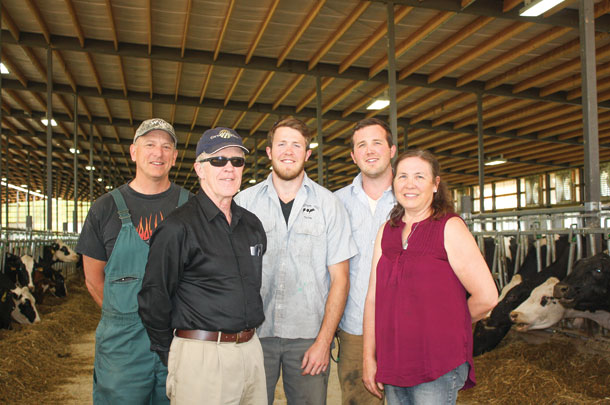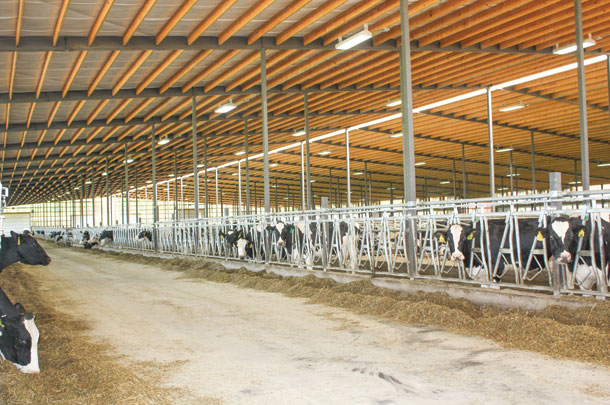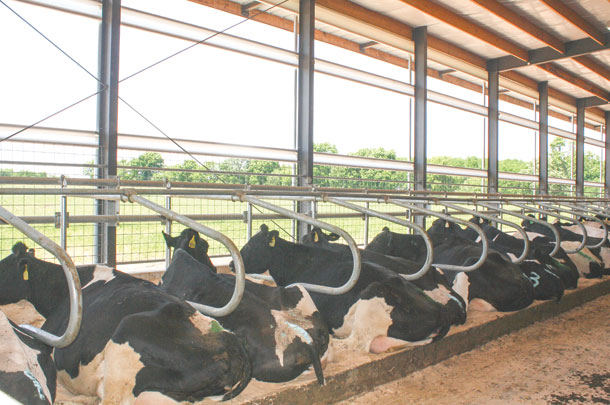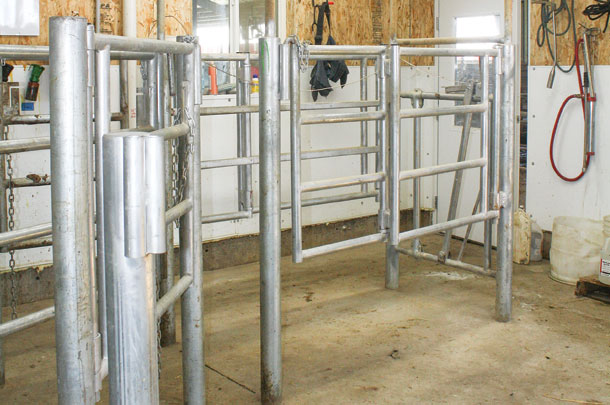At Trillium Hill Dairy, things are really starting to “flow” – cow flow, air flow and work flow – thanks to a new cross-ventilated barn with a unique design.
“Even though there are more cows and more labor, everything just flows so nicely,” Mike Jones says. The dairy located near Berlin, Wisconsin, more than doubled in size over the past year, jumping from 400 cows to 900 cows.
For Mike and his brother Ben, who together manage the operation, more cows did not make more problems. Instead of “trying to fight facilities” as they were in their naturally ventilated 16-year-old, six-row freestall barn, cows are thriving in the new cross vent, with ample space, ultimate comfort and good ventilation and cooling.
 According to the dairy’s herd veterinarian and trusted adviser Dr. Monty Belmer from Waupun Veterinary Service, the results are right in line with the Joneses’ goals. “They wanted a good environment for cattle with good airflow and cow comfort at the same time,” he says.
According to the dairy’s herd veterinarian and trusted adviser Dr. Monty Belmer from Waupun Veterinary Service, the results are right in line with the Joneses’ goals. “They wanted a good environment for cattle with good airflow and cow comfort at the same time,” he says.
Building a baffle-less barn
The Jones brothers included Belmer each step of the way as they toured other barns and sketched out dozens of plans for their own. The cross vent style was appealing because of its smaller footprint and maximized space compared to a tunnel-ventilated barn, but they didn’t want to compromise natural lighting.
Belmer proposed an idea that offered the best of both: a cross-ventilated barn with no baffles.
The purpose of baffles is to increase air velocity and direct air flow down on the cows; therefore, if they were to eliminate baffles, there would be a trade-off. “We knew we would have to run more fans,” Belmer explains. “There was going to be a trade-off of more electrical usage with more fans compared to less fans and baffles.”
A total of 83 fans line one length of the 404-foot-by-215-foot barn, which Belmer says is about 30 more fans than he has seen in a barn of similar size with baffles.

This includes 53 fans measuring 72 inches in diameter to move the wall of air across the cows and a top row of 30 smaller 50-inch fans for maintaining air quality throughout the barn during cold weather. The 72-inch fans do not run in the winter.
After their first winter and a couple of very hot days to test out the system, the Joneses say the baffle-less barn is meeting their expectations. During cold weather, the barn didn’t freeze, and they did not observe respiratory issues – even with adding 500 cows to the herd.
To contrast, Belmer measured the breeze throughout the barn on a recent 90ºF day, satisfied to find it at 5 to 9 miles per hour with full fan power. He adds, “So far, on the warmest days, we’ve been measuring some pretty good wind speeds.” For additional cooling, they have added feedline sprinklers.
Though they built the barn with the option of adding baffles if needed, the Joneses have yet to find a reason to do it.
Built for comfort
Beyond the ventilation system, there are a few other key aspects of the design that make this eight-row barn comfortable and convenient. Compared to the barn that previously housed the milking herd, this one offers more headlocks. The tail-to-tail configuration also makes it is easier to attend to cows that are locked up without the interruption of other cow traffic.
“From both a cow and people standpoint, it makes it a pleasant place to be,” Belmer adds.
Alleys are 12 feet and 14 feet wide with 14-foot crossovers. On each end of the barn, the Joneses built in an additional 12 feet of space, which allows them to turn feeding equipment without having to open the overhead doors. They also use this area to store salt blocks and sodium bicarbonate.
 Ample lighting was very important to the Joneses. That is why they chose a semi-transparent smoke panel to side the barn. From the outside, it looks nearly black, but from the inside, natural sunlight fills the building. They also use timed LED lights for long-day lighting.
Ample lighting was very important to the Joneses. That is why they chose a semi-transparent smoke panel to side the barn. From the outside, it looks nearly black, but from the inside, natural sunlight fills the building. They also use timed LED lights for long-day lighting.
The deep-bedded stalls in the cross-ventilated barn keep cows clean, dry and comfortable, and hock injuries are a thing of the past. Somatic cell count has been 260,000 down to 150,000.
New life for the old barn
The barn that previously served as the main housing for milk cows has a renewed purpose. A group of lactating cows populate one side, and breeding heifers are on the other. This has proven to be a wise utilization of the smaller stalls and lockups, resulting in major improvements to heifer reproductive performance.
To improve comfort and cleanliness in the mattress stalls, they bed with sawdust, but the plan is to eventually convert this barn to sand.

One end of this barn has also been remodeled for dry and prefresh cows with an adjacent calving area and vet room. A swinging gate system easily allows one person to guide a cow into the headlock in the calving pens or to move her from the pen into the vet room. Here, there is a chute where she can be milked or restrained for any necessary treatment or surgery.
An overhead door can be raised or lowered, separating this heated room from the calving pens.
These days, when Mike and Ben look in their new cross-ventilated barn and in the checkbook, they can see that cows are responding well to the change of environment.
They can measure benefits like “a better milk check, less medicine and lower cull rates,” but they also find great satisfaction in having a facility that makes work – and air – flow more efficiently. PD
PHOTO 1: Forgoing baffles meant providing more fan power in the Joneses’ new barn. A total of 83 fans line one side of the cross-ventilated barn, with 72-inch fans along the bottom and an additional row of 50-inch fans along the top.
PHOTO 2: Trillium Hill Dairy recently expanded from 400 cows to 900 cows with the addition of a new barn. From left to right, Dr. Monty Belmer (herd veterinarian), Dr. David Jones, Mike Jones, Ben Jones and Julie Jones.
PHOTO 3: With no baffles to obstruct light, the cross-ventilated barn at Trillium Hill Dairy has an open, airy feel.
PHOTO 4: On the opposite side from the fans, an adjustable curtain controls air being pulled across the barn.
PHOTO 5: Building a new barn allowed the Joneses to remodel their existing barn to better fit their needs. The calving area now includes a heated vet room. Photos by Peggy Coffeen.

-
Peggy Coffeen
- Editor
- Progressive Dairyman
- Email Peggy Coffeen






